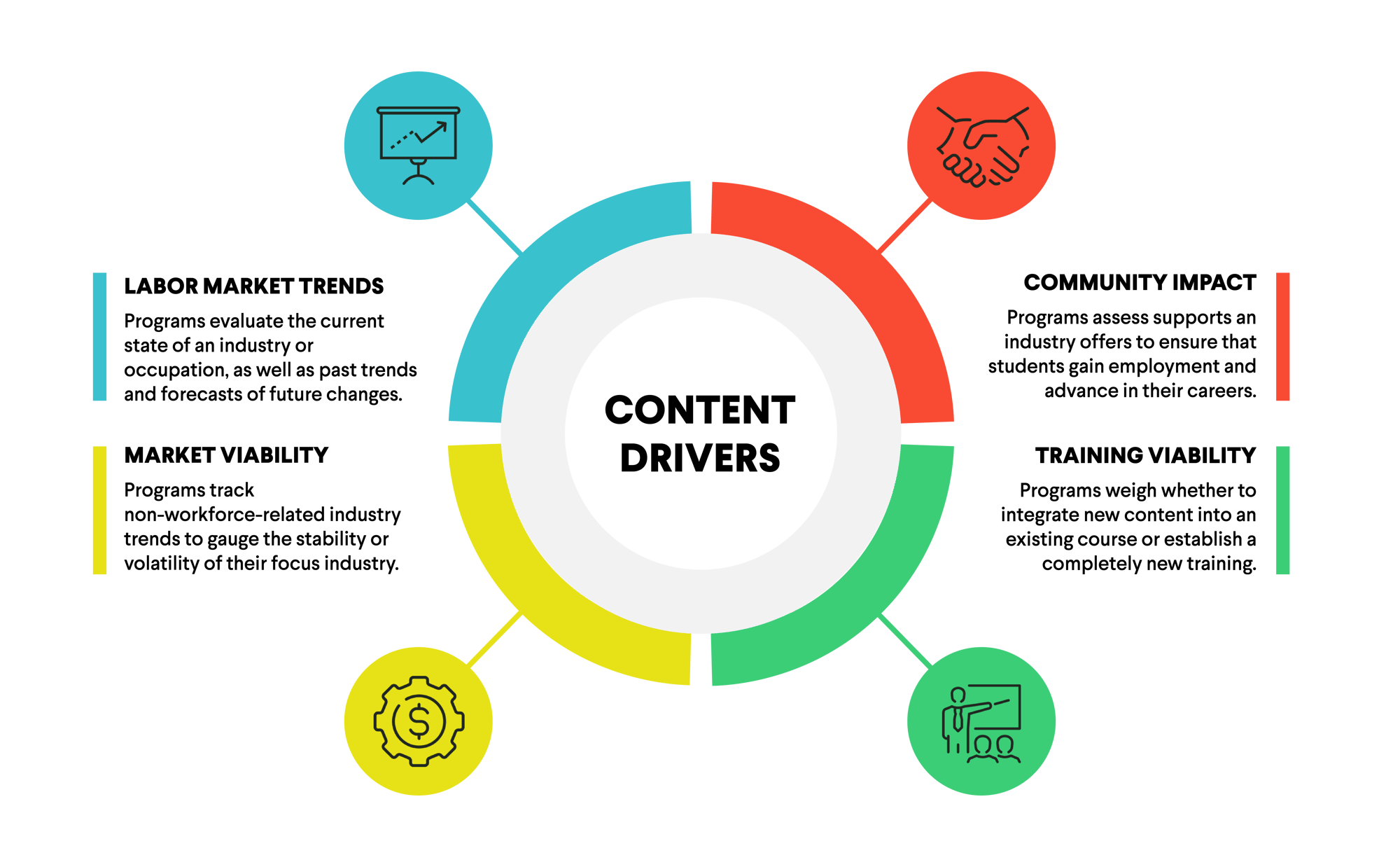A Look at the Changing Economy
A lot has changed in the green economy over the past several years.
- In a World Economic Forum survey of more than 1,000 leading global employers, respondents cited climate-change mitigation as the third most pressing macro concern impacting their business decisions, right behind digital access and the increasing cost of living.1
- LinkedIn found that global demand for green talent grew twice as much as supply from 2023 to 2024, with demand increasing by 11.6% and supply by 5.6%. In the United States, demand grew by 9.8% while supply increased by only 3.1%.2
- At the same time, it’s unclear how tariffs, regulatory changes enacted via the One Big Beautiful Bill Act, and global price pressures will impact green sectors in the United States.3
Through interviews with staff at training programs focused on green skills, Jobs for the Future (JFF) sharpened our insight into what enables the type of longevity that supports lasting regional resilience in a changing economy.
About the Organizations Featured in This Report
Focus Industries
Construction, Manufacturing, Recycling and Reclamation, Renewable Energy, Textiles
Organizational Profiles
The training organizations have been in operation an average of 32 years. Their offerings range from eight-week courses to multiyear apprenticeship programs; overall, the training experiences average six months in length.
Populations Served
Local residents, youth, people with less than a four-year degree, people with criminal records, and members of populations currently underrepresented in the focus industries.
For the full list of the organizations that worked with us as we developed this resource, see the Appendix.
We spoke with employees at 17 training programs run by community-based organizations, community colleges, state universities, social enterprises, and economic development agencies across the country. Training program leaders shared strategies they use to meet the shifting demand for green skills in their regions while positioning their organizations and communities for future success.
How Training Programs Are Meeting the Moment
To get a sense of the types of changes a given program might be grappling with, we opened our interviews by asking staff what the concepts of the “green economy” and “green skills” mean to them. We received a wide range of responses, including these:
- Adhering to the broad concept of environmental sustainability by promoting greater environmental responsibility and proactively mitigating climate-related challenges
- Moving toward a carbon-free economy
- Creating a more circular economy that minimizes waste, with a focus on adapting processes and restructuring supply chains to support that transformation
Regardless of the specific definition they used, interviewees emphasized the need for adaptability.
They said building resilient communities goes beyond supporting initiatives that promote responsible stewardship of natural resources or management of an industry’s environmental impact. It requires nimble and responsive approaches to education and training that can readily adapt to the evolving needs of workers and learners, employers, and regional economies.
"We’re constantly evolving as things change."
Daniel Rowe, Executive Director of Recycling, RecycleForce
To maintain the necessary degree of adaptability, the training leaders said they take a number of factors into account when they make decisions about the types of training to offer and the subjects their programs should cover. The factors fell into the following four broad categories:
- Labor Market Trends
- Market Viability
- Training Viability
- Community Impact
In this resource, we refer to those categories as “content drivers,” and we offer detailed discussions of the role each one plays in the nuanced and multifaceted decision-making processes that training organizations engage in as they determine how to best serve their communities and build resilient regional workforces and economies.
The graphic below offers snapshot summaries of each content driver.

To learn more about each driver, how it influences programmatic decision for organizations, and to access related tools and resources, use the menu to the left. Our goal is to provide examples that can inspire you and other training program leaders to devise your own strategies that emphasize resilience.
Endnotes
- World Economic Forum, The Future of Jobs Report 2025 (Geneva, Switzerland: World Economic Forum, January 2025), https://www.weforum.org/publications/the-future-of-jobs-report-2025/digest/.
- LinkedIn, Global Climate Talent Stocktake: Doubling Green Talent by 2050 to Meet Global Demand, September 2024, https://economicgraph.linkedin.com/content/dam/me/economicgraph/en-us/PDF/linkedIn-global-climate-talent-stocktake-sept-2024.pdf; additional methodology information can be found here: Understanding the Green Transition Supply and Demand Dynamics, LinkedIn, September 2024, https://economicgraph.linkedin.com/content/dam/me/economicgraph/en-us/PDF/understanding-the-green-transition.pdf.
- Rhodium Group and the MIT Center for Energy and Environmental Policy Research, Clean Investment Monitor: The State of US Clean Energy Supply Chains in 2025, April 24, 2025, https://www.cleaninvestmentmonitor.org/reports/us-clean-energy-supply-chains-2025.




